关于四种定位的浅析和测试
static:基于文档流定位。没有产生新的子层。
fixed:脱离文档流定位,基于浏览器视图定位,不保留原来位置。产生新的子层。
absolute:脱离文档流定位,不保留原来位置。产生新的子层。且相对于其最近的先辈(采用fixed,relative或者absolute定位)定位。
Relative:脱离文档流定位,保留原来位置。产生新的子层。相对于自己初始文档流的位置定位。
同时,fixed,absolute和relative产生的子层的z-index默认为0;至于当出现两个图层在同一个位置时,谁覆盖谁,则需要看在文档流中的位置了,总是最新的覆盖旧的。
下面测试和分析:
- static定位,这个是默认定位方式
代码:
DOM
<div class="test1">
<a href="###">我喜欢我</a>
<a href="###">我喜欢我</a>
<a href="###">我喜欢我</a>
</div>
<div class="test2">
</div>
CSS
@charset "UTF-8" ;
*{
margin:0px;
padding: 0px;
}
.test1{
height:100px;
width: 100px;
background-color:grey;
color:red;
}
.test2{
height:200px;
width: 200px;
background-color: yellow;
}
结果:
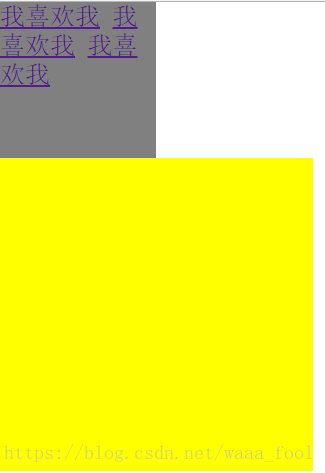
结果分析:
当默认是static定位时,是根据文档流的位置来显示的,block元素独占一行,block元素之间上下罗列,而inline元素则是在block元素内从左到右展示,非独占一行。
2、fixed定位
dom如上;
css:
@charset "UTF-8" ;
*{
margin:0px;
padding: 0px;
}
.test1{
position:fixed;
left:50%;
top:50%;
margin-left: -50px;
margin-top: -50px;
height:100px;
width: 100px;
background-color:grey;
color:red;
}
.test2{
height:200px;
width: 200px;
background-color: yellow;
}
结果:
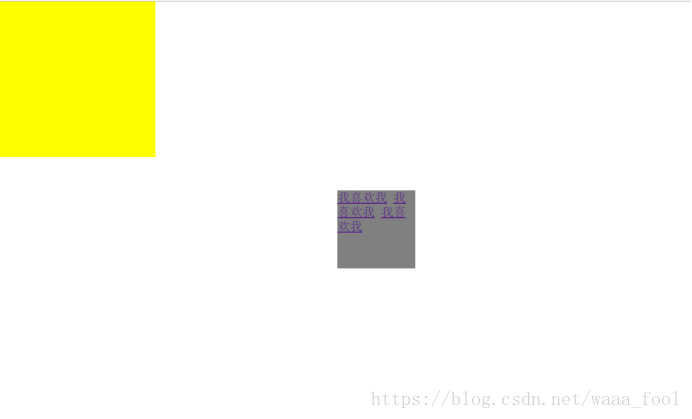
结果分析:无论如何拉动浏览器右侧的翻页,均保持在用户浏览器界面的中心。同时我们可以看到fixed定位的原本文档的位置没有保留(也就是表现的黄色框移动到上面位置),同时,我们可以发现,如果将黄色的区域扩到到width:700px;height:700px;结果如下图:
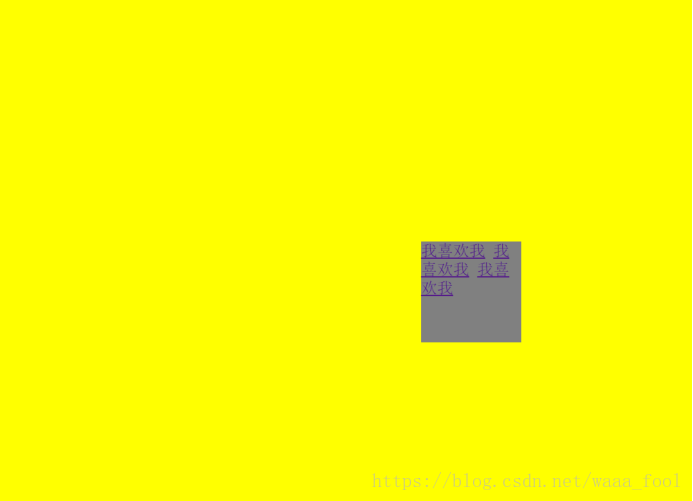
我们发现,灰色区域仍然存在原位置,黄色区域的位置也没被改变,这说明,他们分层次了,可以想象成空间z轴上不同层次,人从z轴上半轴顶部俯视。甚至此时我们将黄色区域的z-index:999;和灰色区域的z-index:0;(z-index表示的是z轴,我们电脑屏幕是x,y确定的二维平面,图层也有上下之分,即这个层次是z轴,用z-index来设置,越大就离我们越近,即z-index大的图层覆盖z-index小的图层)仍然没有用,为什么呢?其实就是因为你没有给黄色区域设置position:fixed/absolute/relative,z-index设置只能在这三种定位中有效。
所以总结一下:fixed会创造一个新的层,且脱离原来位置定位。其位置会固定在浏览器一个位置,不改变。
拓展:关于定位和z-index,还有一个故事,就是从父原则,想看分析的可以去这儿。
3、absolute:脱离原来位置定位。
dom代码不变
css
@charset "UTF-8" ;
*{
margin:0px;
padding: 0px;
}
.test1{
position: absolute;
height:100px;
width: 100px;
background-color:grey;
color:red;
}
.test2{
height:200px;
width: 200px;
background-color: yellow;
}
结果:
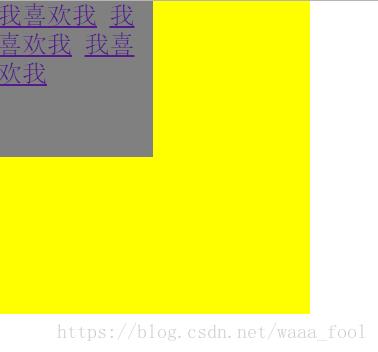
结果分析:我们可以看到出现了和fixed定位一样的情况,不再保留灰色区域的文档流位置,同时进行了分层次。
再看一个测试:
dom
<div class="test1">
<div class="test2">
</div>
</div>
css
@charset "UTF-8" ;
*{
margin:0px;
padding: 0px;
}
.test1{
margin: 20px;
height:200px;
width: 200px;
background-color:grey;
color:red;
}
.test2{
position: absolute;
top:10px;
left: 10px;
height:100px;
width: 100px;
background-color: yellow;
}
结果:
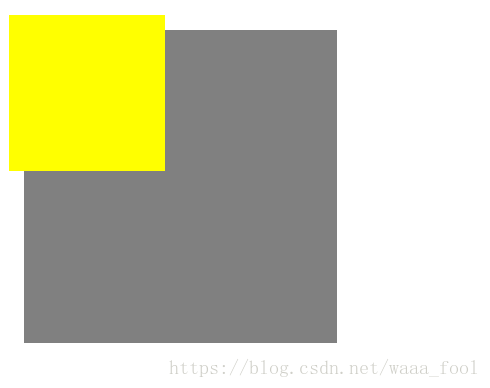
我们把灰色区域的position改为fixed,absolute或者relative的话,就会出现如下结果:
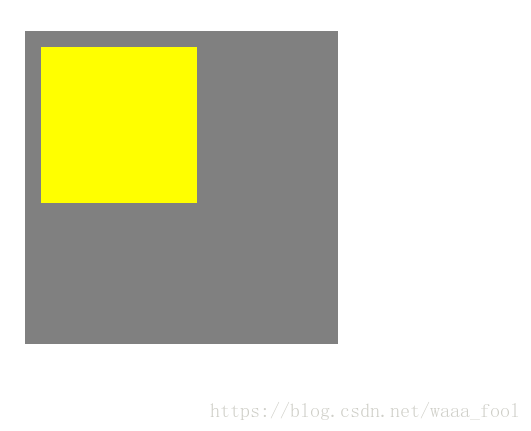
分析:其实absolute是寻找其长辈元素中第一个非static定位的父辈元素进行定位。
总结:absolute定位是脱离原来位置的定位,其会变成一个新的层次。
4、relative:保留原来位置的定位
dom
<div class="test1">
</div>
<div class="test2">
</div>
css
@charset "UTF-8" ;
*{
margin:0px;
padding: 0px;
}
.test1{
position: relative;
top:250px;
left:250px;
height:200px;
width: 200px;
background-color:grey;
}
.test2{
height:300px;
width: 300px;
background-color: yellow;
}
结果:
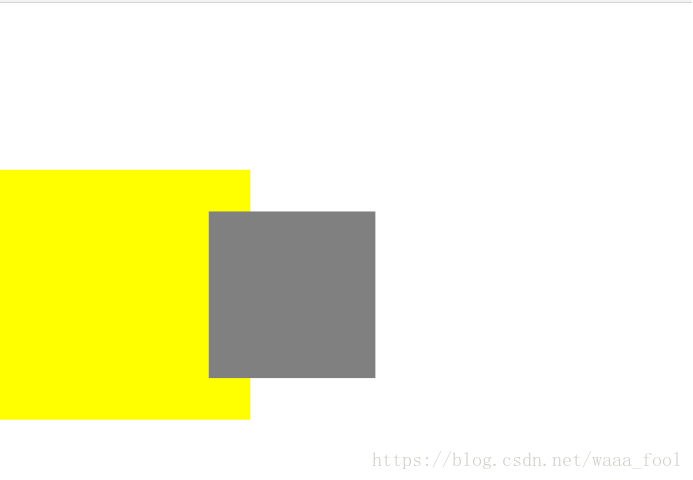
结果分析:我们可以看到,分层了,同时灰色位置的文档流位置保留。
再看另一个测试:
dom
<div class="test1">
<div class="test2">
</div>
</div>
css
@charset "UTF-8" ;
*{
margin:0px;
padding: 0px;
}
.test1{
margin:50px;
height:200px;
width: 200px;
background-color:grey;
}
.test2{
position: relative;
height:100px;
width: 100px;
background-color: yellow;
}
结果:
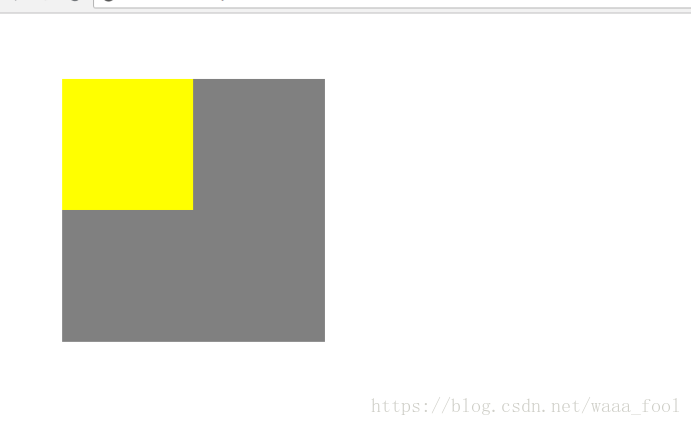
结果分析:我们不管改变灰色区域的position为何值。位置都不变,实际上,relative的定位总是相对于父元素定位。
总结:relative定位会生成子层。同时relative相对于初始文档流位子定位。
5、生成子层颜色的覆盖
dom
</div>
<div class="test2">
</div>
<div class="test3">
</div>
css
@charset "UTF-8" ;
*{
margin:0px;
padding: 0px;
}
.test1{
position: fixed;
top:70px;
height:200px;
width: 200px;
background-color:grey;
opacity: 1;
}
.test2{
position: relative;
top:0px;
height:100px;
width: 100px;
background-color: yellow;
}
.test3{
position: relative;
top:-50px;
height: 100px;
width:100px;
background-color: red;
}
结果:
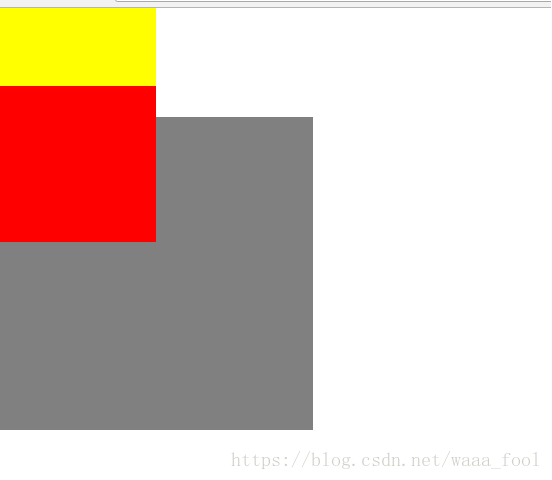
结果分析:z-index相同时,总是依照文档流进行覆盖,即html中新的覆盖旧的。
全篇总结:
static:基于文档流定位。没有产生新的子层。
fixed:脱离文档流定位,基于浏览器视图定位,不保留原来位置。产生新的子层。absolute:脱离文档流定位,不保留原来位置。产生新的子层。且相对于其最近的先辈(采用fixed,relative或者absolute定位)定位。
Relative:脱离文档流定位,保留原来位置。产生新的子层。相对于父元素定位。
同时,fixed,absolute和relative产生的子层的z-index默认为0;至于当出现两个图层在同一个位置时,谁覆盖谁,则需要看在文档流中的位置了,总是最新的覆盖旧的。




















 4114
4114

 被折叠的 条评论
为什么被折叠?
被折叠的 条评论
为什么被折叠?








